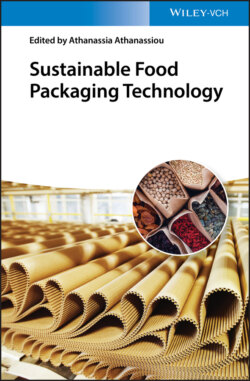Читать книгу Sustainable Food Packaging Technology - Группа авторов - Страница 2
Table of Contents
Оглавление1 Cover
2 Title Page
3 Copyright
4 Preface References
5 Part I: Review on Biopolymers for Food Protection 1 Emerging Trends in Biopolymers for Food Packaging 1.1 Introduction to Polymers in Packaging 1.2 Classification of Biopolymers 1.3 Food Packaging Materials Based on Biopolymers 1.4 Concluding Remarks References 2 Biopolymers Derived from Marine Sources for Food Packaging Applications 2.1 Introduction 2.2 Fish Gelatin Films and Coating 2.3 Chitosan Films and Coatings 2.4 Future Perspectives and Concluding Remarks References 3 Edible Biopolymers for Food Preservation 3.1 Introduction 3.2 Polysaccharides 3.3 Proteins 3.4 Lipids 3.5 Edible Composite Materials 3.6 Active Coatings 3.7 Materials Selection and Application 3.8 Conclusions References
6 Part II: Food Packaging Based on Individual Biopolymers and their Composites 4 Polylactic Acid (PLA) and Its Composites: An Eco‐friendly Solution for Packaging 4.1 Introduction 4.2 Synthesis of PLA and Its Properties 4.3 Properties Required for Food Packaging 4.4 General Reinforcements for PLA 4.5 Biodegradability of PLA 4.6 Conclusions and Future Prospects References 5 Green and Sustainable Packaging Materials Using Thermoplastic Starch 5.1 Sustainability and Packaging: Toward a Greener Future 5.2 Thermoplastic Starch 5.3 Thermoplastic Starch‐Based Materials in Packaging 5.4 Conclusions References 6 Cutin‐Inspired Polymers and Plant Cuticle‐like Composites as Sustainable Food Packaging Materials 6.1 Introduction 6.2 Synthesis of Cutin‐Inspired Polyesters 6.3 Cutin‐Based and Cutin‐like Coatings and Composites 6.4 Concluding Remarks Acknowledgments References 7 Zein in Food Packaging 7.1 Introduction 7.2 Solvent Cast Zein Films 7.3 Chemical Characteristics of Solvent‐Cast Zein Films 7.4 Extrusion of Zein 7.5 Zein Laminates with Various Packaging Films 7.6 Zein Blend Films with Other Biopolymers 7.7 Outlook and Future Directions 7.8 Conclusions References
7 Part III: Biocomposites of Cellulose and Biopolymers in Food Packaging 8 Cellulose‐Reinforced Biocomposites Based on PHB and PHBV for Food Packaging Applications 8.1 Introduction to Bioplastics 8.2 PHB and PHBV: a SWOT (Strength, Weakness, Opportunity, and Threat) Analysis 8.3 Cellulose Biocomposites 8.4 PHA/Fiber Composites 8.5 Conclusions References 9 Poly‐Paper: Cellulosic‐Filled Eco‐composite Material with Innovative Properties for Packaging 9.1 Introduction 9.2 Materials 9.3 Mechanical Properties 9.4 Suitable Processes for Poly‐Paper 9.5 Additional Properties of Poly‐Paper 9.6 End‐of‐Life 9.7 Conclusions References Notes 10 Paper and Cardboard Reinforcement by Impregnation with Environmentally Friendly High‐Performance Polymers for Food Packaging Applications 10.1 Introduction 10.2 Improving the Barrier Properties of Paper and Cardboard by Impregnation in Capstone and ECA Solutions 10.3 Water, Oil and Grease Resistance of Biocompatible Cellulose Food Containers 10.4 Conclusions References 11 Nanocellulose‐Based Multidimensional Structures for Food Packaging Technology 11.1 Introduction 11.2 Necessities in Food Packaging Industry 11.3 An Overview of NC 11.4 Cellulose Fibrils and Crystalline Cellulose 11.5 Why NC for Packaging? 11.6 Effect on NCs on Networking 11.7 Migration Process of Molecules Through NC Dimensional Film 11.8 Processing Routes of NC‐based Multidimensional Structures for Packaging 11.9 CNFs for Barrier Application 11.10 CNCs for Barrier Application 11.11 Conclusion References
8 Part IV: Natural Principles in Active and Intelligent Food Packaging for Enhanced Protection and Indication of Food Spoilange or Pollutant Presence 12 Sustainable Antimicrobial Packaging Technologies 12.1 Introduction 12.2 Antimicrobial Food Packaging 12.3 Natural Antimicrobial Agents 12.4 Conclusions and Perspectives References 13 Active Antioxidant Additives in Sustainable Food Packaging 13.1 Introduction 13.2 Antioxidant Capacities of Plant‐Based Food Packaging Materials 13.3 Conclusions and Future Perspectives References 14 Natural and Biocompatible Optical Indicators for Food Spoilage Detection 14.1 Food Spoilage 14.2 Food Spoilage Detection 14.3 Natural and Biocompatible Optical Indicators for Food Spoilage 14.4 Concluding Remarks and Future Perspectives References
9 Part V: Technological Developments in the Engineering of Biocomposite Materials for Food Packaging Applications 15 Biopolymers in Multilayer Films for Long‐Lasting Protective Food Packaging: A Review 15.1 Introduction 15.2 Biopolymer Coatings and Laminates on Common Oil‐Derived Packaging Polymers 15.3 Multilayer Films Based on Proteins 15.4 Multilayer Films Based on Polysaccharides 15.5 Coatings on Biopolyesters 15.6 Summary and Outlook References
10 Index
11 End User License Agreement
